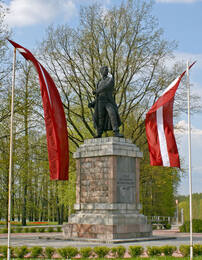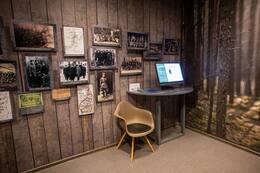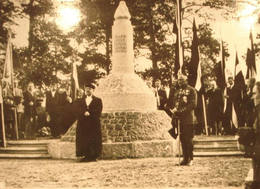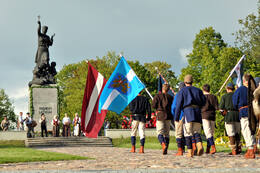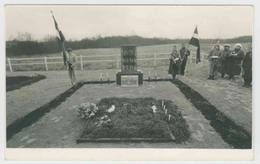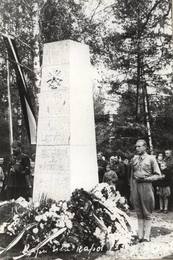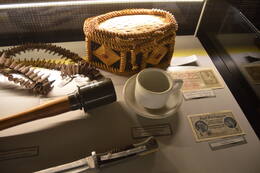Partisan activity in Northern Latgale
I Wars of Independence
The first Latgale partisan attacks on the Soviet Latvian army began in March 1919. In May, several large military units of about 30 men were established in Kuprava, Rugāja and elsewhere. On May 29 and 30, partisan units attacked parts of the Soviet Latvian army coming from North Vidzeme through Balvi. On June 15, the Bolshevik armed train managed to occupy Kuprava station, on June 21 they tried to make a repeated attack in the direction of Balvi station. The partisans, together with about 100 Estonian soldiers, surrounded the train and forced it to retreat in the direction of Pitalova. In the summer of 1919, partisans captured Liepna and Balvi with the support of Estonian soldiers.
On July 5, 1919, the representatives of the partisan groups decided to unite in one regiment at the meeting in Balvi; Initially, the partisan regiment had four ornaments. From July 13, the regiment came under the command of the commander of the Kurzeme division. 28.-30. In July, fights took place near Baltinava and at Punduri station, Vilaka was captured. After the battles at Stompakai and Susāja, the 5th Company of the Regiment was formed from the local partisans. On August 9, the 6th Company was formed from the Liepna Partisan Division, which occupied Liepna on September 22. In October 1919, the partisan regiment grew to 2,000 men, so it was reorganized and formed three battalions with 8 ornaments, and the 9th company formed a fourth battalion. On October 4, Lieutenant Colonel Jānis Skujiņš (1897-1942) was appointed commander of the regiment. On October 16, the 2nd Battalion of the regiment occupied Nostrov and Stompakus. 7.-9. In November, the Red Army counterattacked and regained the positions lost in October. In January 1920, the regiment had 49 officers and 2,400 fighters, who also had machine guns. The regiment took part in the liberation operations of Northern Latgale in January and February 1920.
During the War of Independence, the Latgale partisan regiment lost 145 dead. 40 soldiers of the regiment were awarded the Lāčplēsis War Order.
On August 14, 1938, at the intersection of Brīvības and Partizānu streets in Balvi, a monument to the fallen soldiers of the Latgale partisan regiment "Guarding partisan" was unveiled.
More information sources
Jānis Skujiņš. Latgale partisan regiment. Book: To commemorate the 15th anniversary of the liberation of Latgale. 1920-1935 Rezekne, 1935, pp. 32-33; also: http://www.periodika.lv/periodika2-viewer/view/index-dev.html#panel:pp|issue:/g_001_0307061306|article:DIVL259|page:32|issueType:undefined
Latgale partisan regiment. Wikipedia. https://en.wikipedia.org/wiki/Latgales_partiz%C4%81nu_pulks
Related timeline
Related objects
Monument to the fallen soldiers of the Latgale partisan regiment 1919 - 1920
A monument dedicated to the Latgale partisan regiment.
In the history of the War of Independence of Latvia (1919-1920), the Latgale partisan regiment, whose cradle was once in the territory of the former Balvi district, was formed from the "green" regiments already at the end of 1918.
The monument was opened for the first time on August 14, 1938, with the participation of General Jānis Balodis. The author of the monument is the artist Kārlis Jansons.
In 1940, the communists destroyed the monument, after the establishment of Soviet power, the executive committee of Abrene district decided to demolish the monument in the spring of 1941, but the image of the partisan was buried in the courtyard of the Balva militia. During the German era, the monument was restored, but when the Red Army returned, the monument was torn down a second time, taken away and destroyed. When Latvia regained its national independence, the people of Balveni collected donations for the restoration of the Latgale partisan monument. On November 11, 1993, the restored monument of Andrej Jansons, the son of the artist Kārļis Jansons, was unveiled at Balvos.
Exhibition "Ziemeļlatgale in the freedom struggle" in Balvu County Museum
The exhibition allows you to look into the history of Latvian Independence from the point of view of Northern Latgale. What is the contribution of the people of our side, how did our grandfathers get involved in the fight for the common cause of Latvia, what are their fates, how is their memory preserved? Answers to these and other questions can be found in Latvian, Russian and English.
The Northern Latgale liberation operation, also called the Viļakas-Jaunlatgale capture operation, was part of the Latgale liberation attack operation carried out by the Latvian armed forces during the Latvian freedom struggle. Its purpose was to occupy the northern part of Latgale and cut the Pskov-Daugavpils railway line in order to prevent the arrival of additional units of Soviet Russian troops from the Estonian front and from inside Russia. The most important battles took place between January 9 and 20, 1920, when control over the railway line from Pitalova (Abrene) to Kārsava was gained.
A monument to the soldiers who died in the battles for the liberation of Latvia in Jaškov
The road section Viļaka – Vientuļi (P35) is on the left side of the road, near the chapel of the Jaškova grave.
Monument to Latvian and Estonian soldiers who died in the War of Independence.
The monument created by the sculptor Kārlis Zemdega in 1920 in memory of the soldiers who fell in the Freedom Struggle in Jaškov was first unveiled on September 22, 1935 at the graves of the Viļaka brothers established in 1929.
The struggle for freedom against the Red Army in Viļakas district began with the attack of the Latvian army and the Latgale partisan regiment on January 9, 1920. Estonian soldiers also participated in it. Viļak was liberated already on January 9, but the fighting to the east of it continued for several more days. Both before and after the liberation of Vilakas, the fallen soldiers were buried in different places known to local residents. As the state of Latvia stabilized, Viļakas began to think about setting up joint graves of brothers. Already from November 18, 1923, after a solemn service in the Catholic church, held by dean P.Apšinīks, a large procession went to the newly formed burial place of the brothers on the hill, in the so-called Jaškov - in the immediate vicinity of Viļaka. Soon, the foundation of the monument was built, the collection of donations for the monument began. Identifying the graves of the fallen soldiers took time, only on November 3, 1929, the reburial took place in the future graves of the brothers. The 31 Latvian and 14 Estonian soldiers who fell in the vicinity of Viļakas were buried in them. In 1935, the monument was ready and on September 22, it was solemnly consecrated.
In the pre-war years of Latvia's independence, all important national events in Viļaka parish were connected with the brothers' graves and this monument.
The monument was destroyed during the post-war years of Soviet rule, but its granite parts, although damaged, were preserved. The monument was restored on November 11, 1990 - Lāčpleš Day.
"United Latvia" monument
The monument to the liberation of Latgale (popularly known as "Latgales Māra") is the most recognizable symbol of Rēzekne. Dedicated in 1920 to the participants of the Latvian freedom struggle and embodies the idea of the freedom and unity of the Latvian state. The monument was opened in 1939. (artist L. Tomasickis, sculptor K. Jansons), its bronze sculptural composition consists of: a chain puller, symbolizing the freedom won by the heroic sons of Latgale over foreign powers, a kneeling girl next to him crowns the liberator with a wreath of oak leaves, and above both figures - a national daughter who in his hand he holds a raised golden cross - symbolizing faith and satisfaction for regained freedom.
1940 the monument was demolished in 1943 it was restored, but in 1950 the ruling power destroyed it. In 1992, thanks to the funds donated by the people, the monument rose again in all its glory on the hill of Liberation Alley (sculptor A. Jansons).
Memorial stone for the green partisans
It is located at the corner of Parka and Saules streets in Ergļi, near the railway viaduct.
On May 23, 1919, the green partisans attacked a column of Vezumniki of the greats in the center of Ergli. The battle lasted two hours, and the partisans got 78 horses and many carts with rifles and other goods. Four partisans died in the battle, and one was injured. In total, 61 men fought in the ranks of the partisans in the county, six of whom died.
On May 21, 1939, a memorial stone of the 121st Eagle Regiment was opened in the village of Eagles at the place where the green partisans Jānis Andriksons, Andrejs Bumbers, Kārlis Baņgieris and Jānis Gūts fell on May 23, 1919.
During the Soviet occupation, the memorial sign at the intersection of Parka and Saules streets was demolished. It was restored and re-installed on April 22, 1989.
Related stories
Liberation of Northern Latgale from the Bolsheviks
On December 1, 1918, parts of the Red Army, based on the Red Rifle units, invaded the territory of Latvia. In order to protect their homes, families, native counties and escape from terror, the men around Balvi took up arms and went into the forests, and the first "green" groups began to form. In the spring of 1919, when the mobilization was announced, many men in the Balvi area were not allowed to fight in the Soviet Latvian army and they joined the "green" groups. Balvi, Silakrog, Rugāji, Teteru-Dūrupe and Liepna groups were formed. In the vicinity of Balvi, the activity of "green" groups became more active in March 1919.





